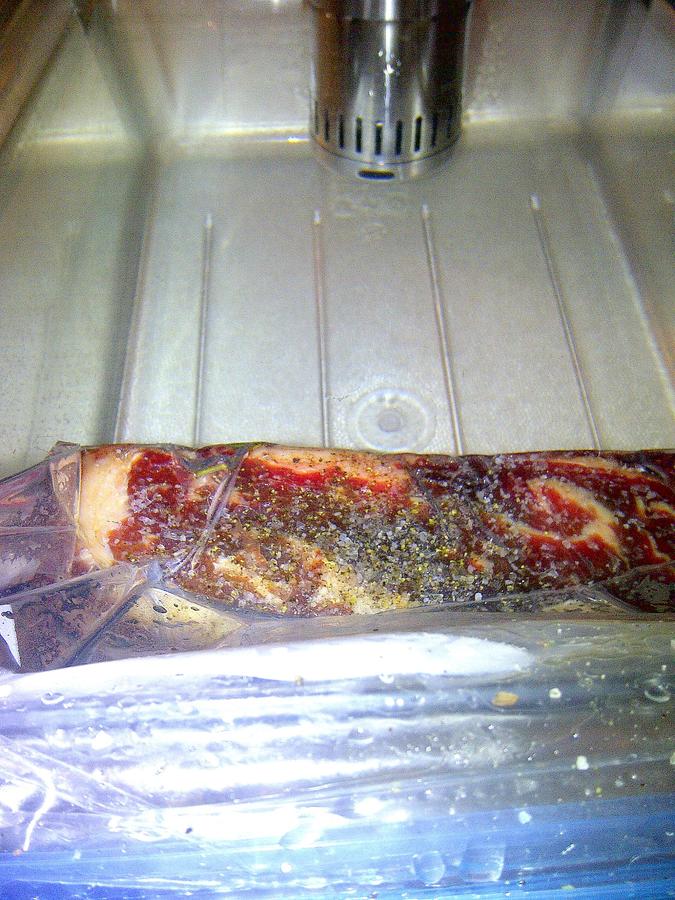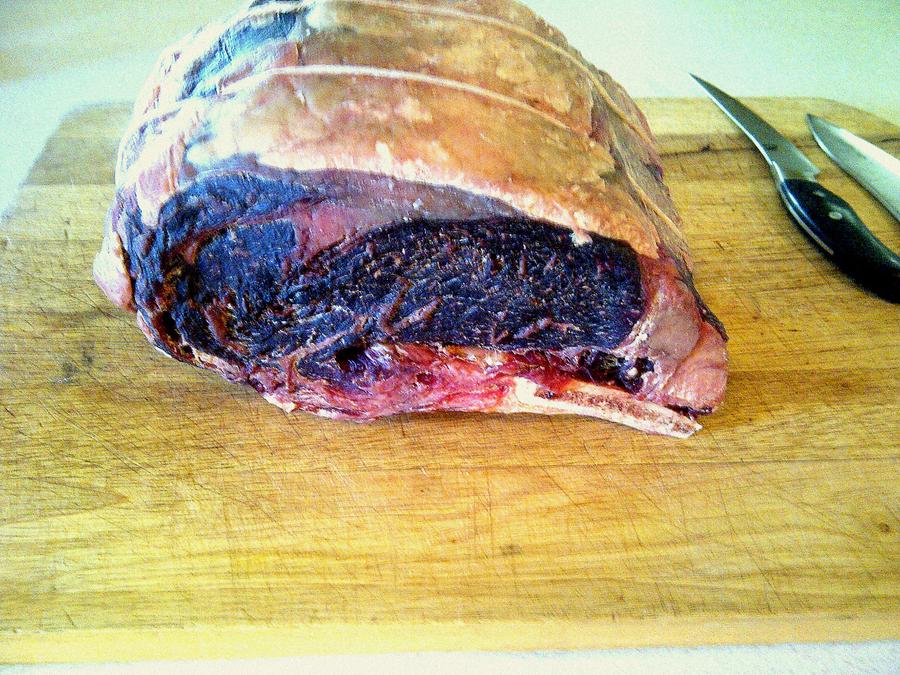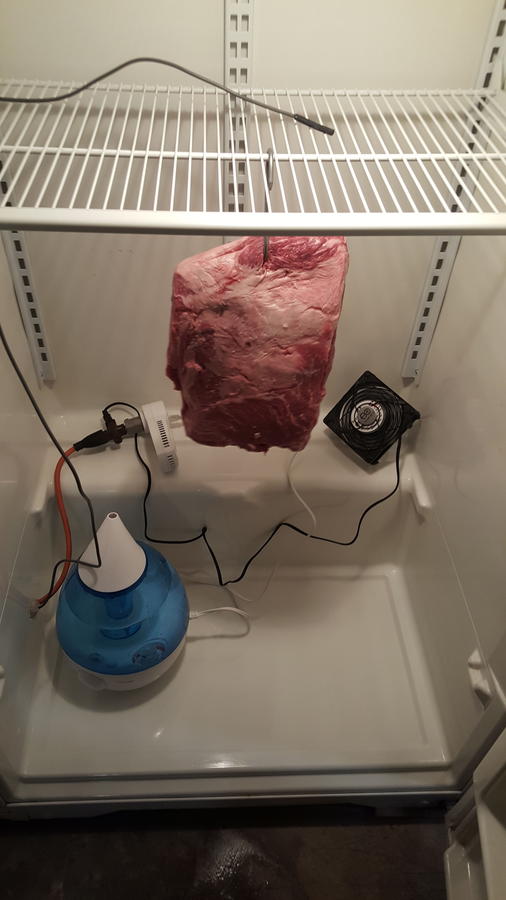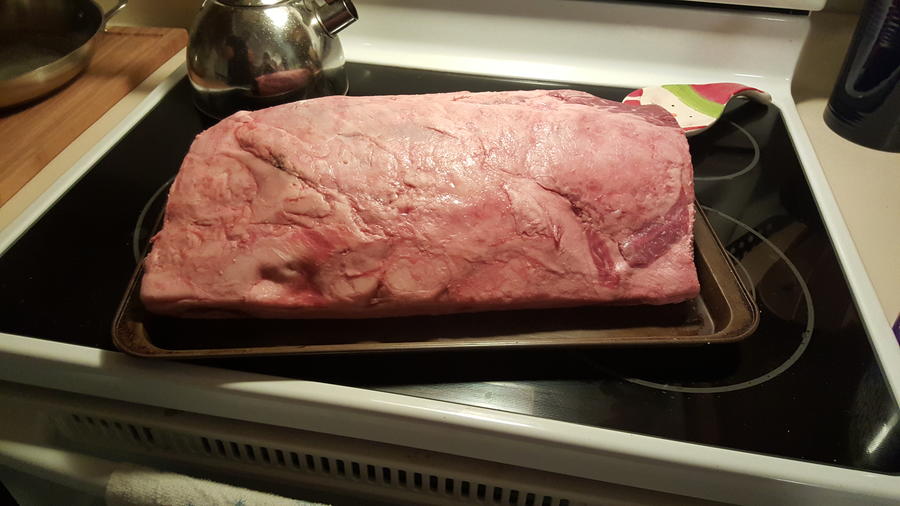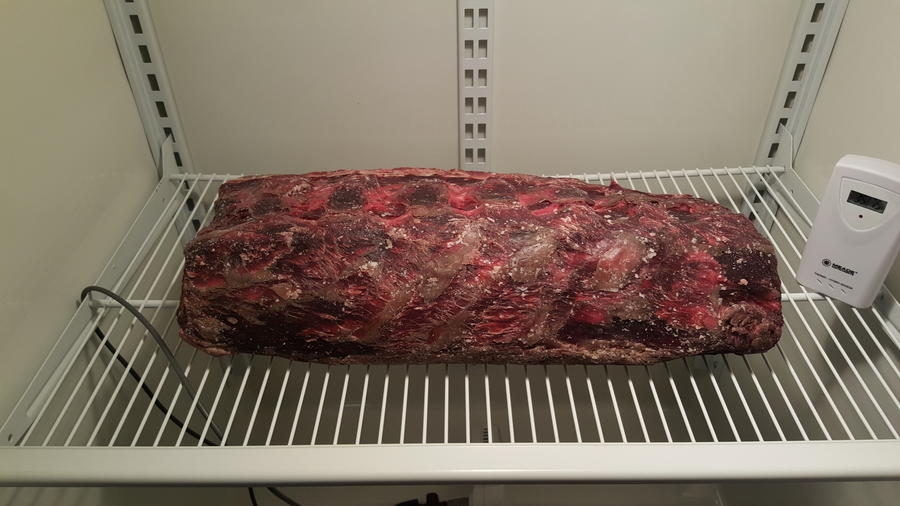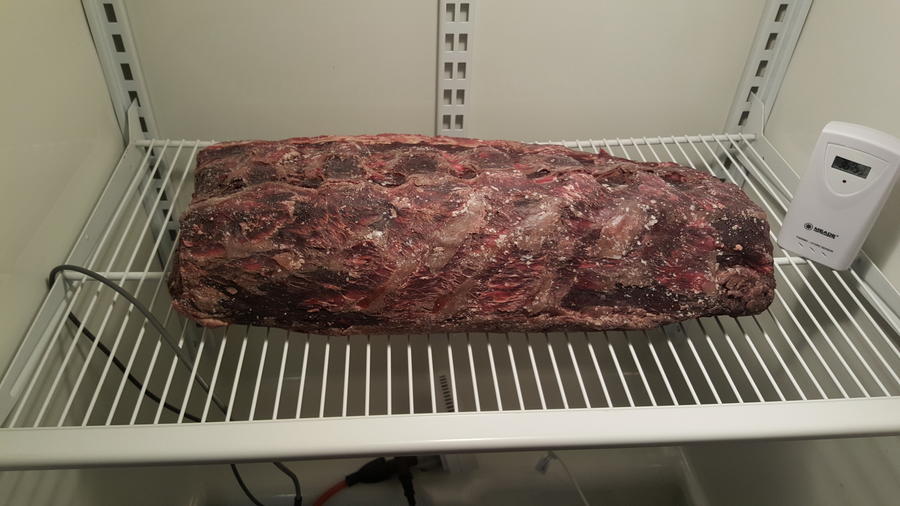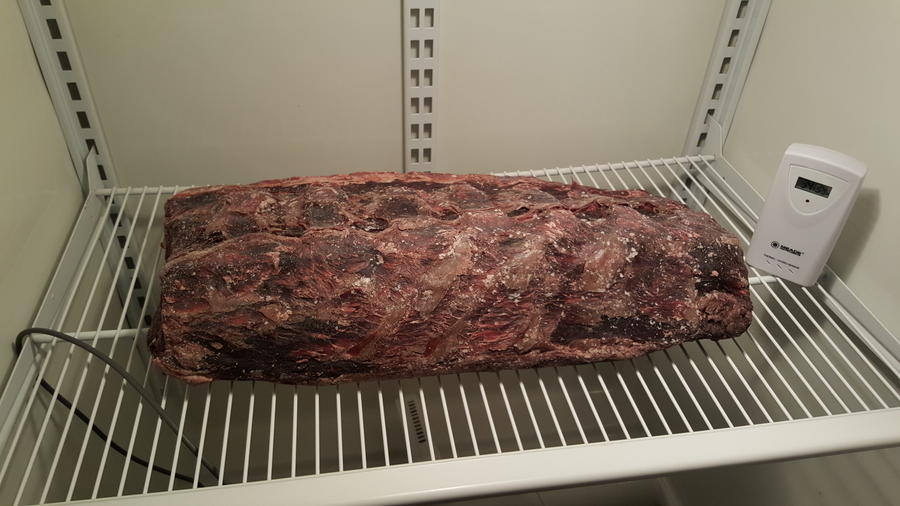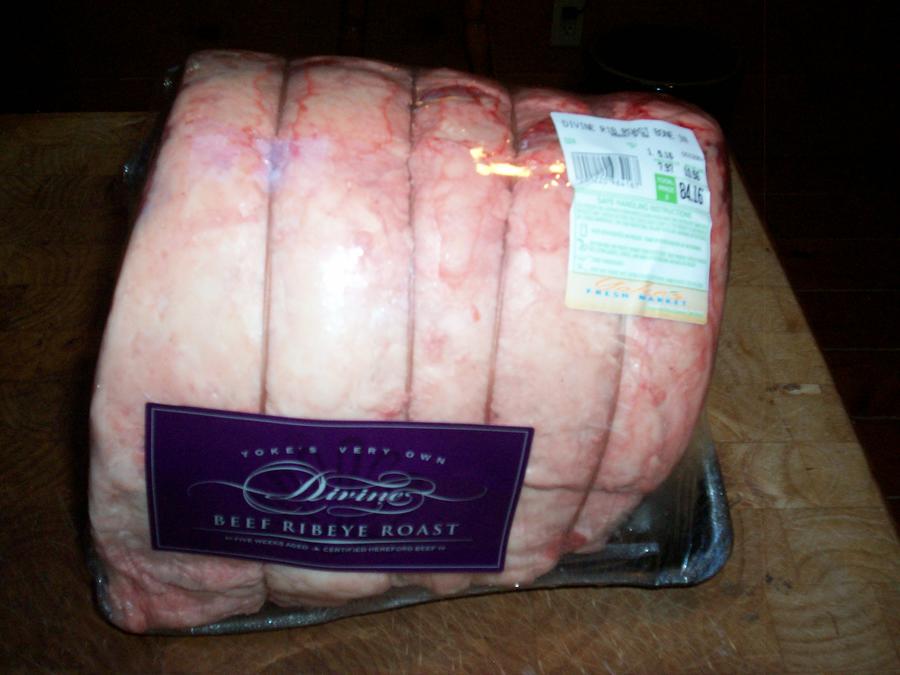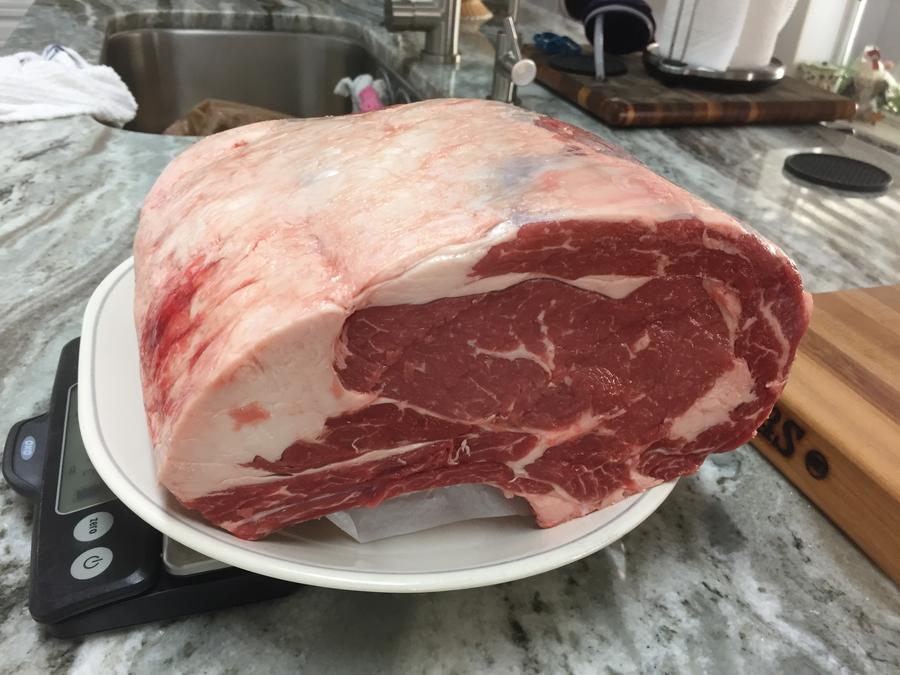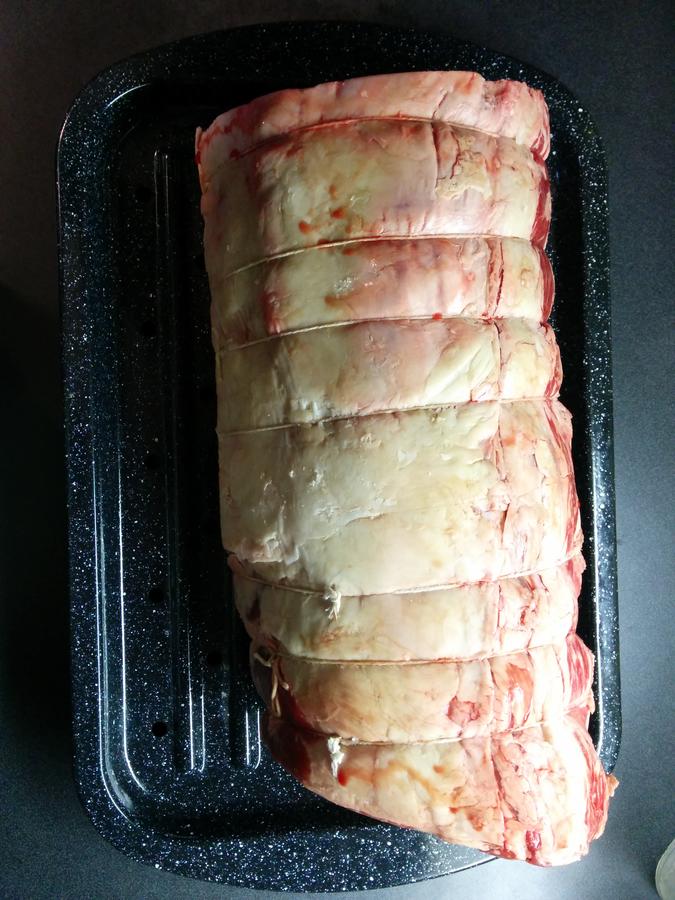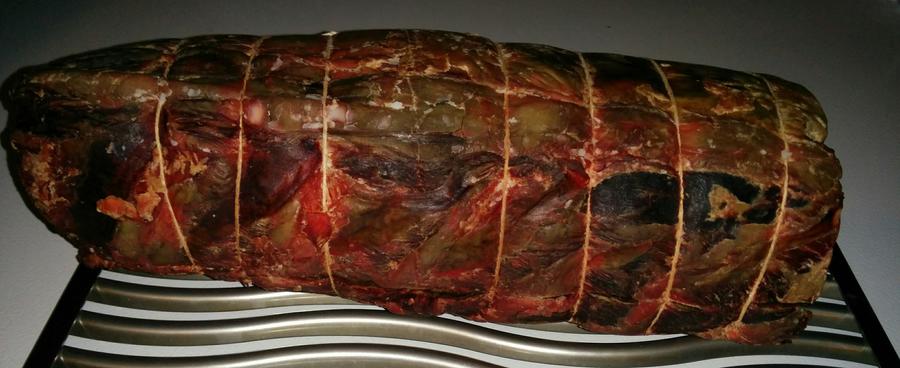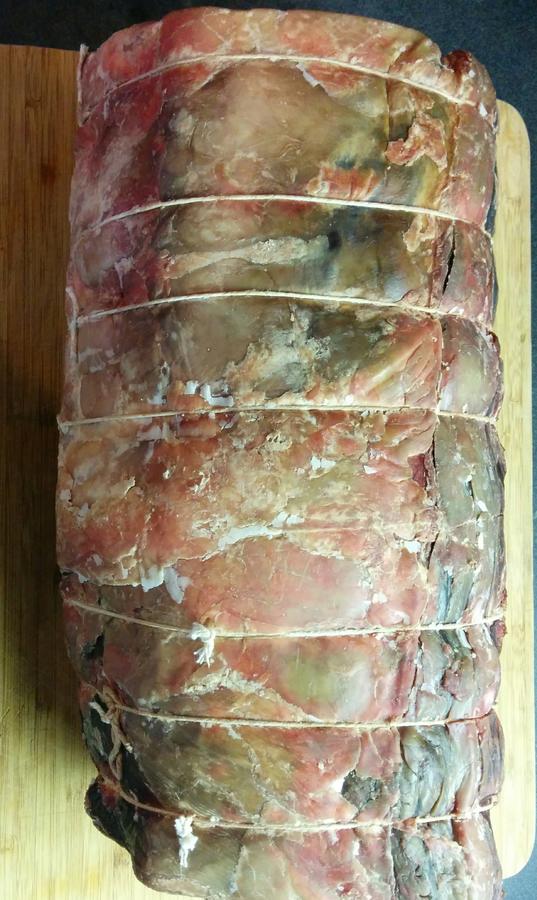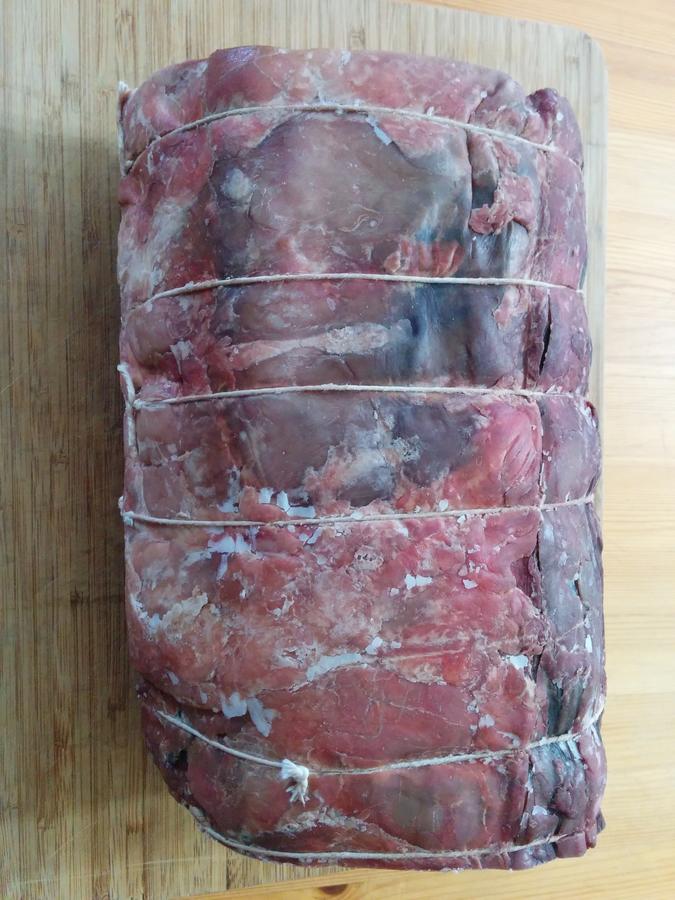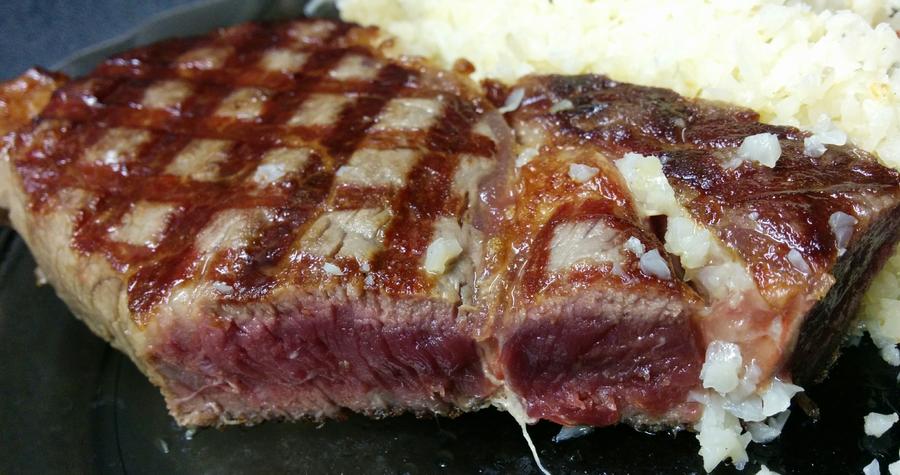Dry-Aged Prime Rib Roast and Steaks + Illustrations & Comments from Multiple SMF Members
The following is a compilation of individual dry aged beef projects involving a few forum members. Used throughout the entire process were several aging techniques and cooking procedures. This was to be the first journey for some, closely monitored by those with more experience. The objective of the project was to attempt to replicate dry-aged beef roasts and steaks prepared by those who do it professionally that can only be purchased at the highest of the high-end steakhouses, or specialty retailers. The intent of this thread was not only to teach, but to also enlighten and encourage those who may have had an interest in dry-aging.
The aging of beef is normally thought of as the storage time, in days or weeks, from slaughter until processing. Processing is breaking down the carcass into retail cuts. Beef aging is a biochemical process which breaks down the meat’s connective tissues making it tenderer. This takes place after the slaughter when the lack of oxygen initially triggers rigor mortis, or the hardening of soft muscle tissue.
It is only at this stage that the enzymatic aging starts, which is roughly 4 to 10 days when the meat tissue s turn soft again. However, such a period of time can vary depending upon sex, breed, and age of the animal at the time of slaughter. To further intensify the flavor, the beef can be aged for many additional days/weeks provided it is handled properly.
Beef aging comes in two methods – Dry aging or wet aging.
Dry-Aged Beef
For dry-aging, whole sides of beef or primal cuts are hung in open air at a temperature just above freezing and left to age for several weeks. Not only are the enzymes working on the muscle tissues during this time, but also the meat is slowly dehydrating. This concentrates the meat and changes the texture and flavor.
The benefit of this process is very tender meat with an intense flavor. The downside is that you lose quite a bit of the meat due to moisture loss, which decreases the yield and increases the cost per pound. In addition, the surface of the meat usually needs to be trimmed away before the beef is portioned and sold, resulting in further loss of volume.
Wet-Aged Beef
Wet-aging is a relatively recent technique that developed along with advances in plastics and refrigeration. In this process, cuts of beef are vacuum-sealed in plastic and shipped to the market. The aging takes place in the 4-10 days between slaughter and sale while the meat is in transit.
Which is Better?
Honestly, it's a matter of preference. The biggest difference between the two kinds of meat is in the flavor. Dry-aged beef can be described as having a roasted, nutty flavor, while wet-aged beef can taste slightly metallic and lacks the same depth of flavor.
Unless the beef is specifically labeled as dry-aged, the meat you buy in the store has almost definitely been wet-aged. Most of us have come to associate the flavor of beef with wet-aged meat, to the point that dry-aged beef might not taste as palatable anymore.
You should definitely try some dry-aged beef if you have the opportunity, you may find the split from the ordinary, delightful. It costs a lot more and is harder to find, but it's worth knowing that there are other options out there.
Cooking Options:
Whole roast in oven
Salt crusted in oven
Steaks cut and baked in an oven
Whole roast on grill, indirect heat followed by sear (reversed sear)
Steaks on grill indirect heat followed by sear (reversed sear)
Steaks on grill direct sear
Sous Vide steaks or roast
Searing:
Broiler
Grill
Pan, with or without torch
Note from Mr. T: It was truly a pleasure working with everyone who took a part in this project. For the first timers, it takes courage and determination to watch an expensive cut of meat wither into something never seen before, good job.
It is my wish that this combined thread will encourage other adventurist to give dry-aging a try.
The illustrations used here represent four diverse ways to age a prime rib roast, cold room, full-size kitchen refrigerator, mini-refrigerator, and a commercial reach-in cooler. Each produced exceptional results.
Mr. T

AK1
Today at 7:52 am
Original message sent by ak1 on 2/23/16 at 2:53am
This was an experiment in dry aging beef at home, to see if one could accomplish a proper dry aged piece of meat without the exorbitant expense of buying dry aged beef. Looking at cost, my original roast was bought for $5.99 lb and cost close to 40 bucks. So after trimming I'm around 17 bucks per pound as well. If I had bought this I'd be at least 30 bucks per pound.
I had a nice 7+ pound standing rib roast for this experiment.
I used my cold cellar for the ageing just because the temps were good. Around 38* and 80% humidity. Started on January 15th.
View media item 454927
Sitting on a rack over some salt just to absorb excess moisture.
Here we are 2 weeks in.
View media item 449690
I had checked on it periodically to make sure all was OK and that there was no bad mould growth.
On February 14th I took it out
View media item 454929
At this point it weighed around 5 lbs. Lost around 30% weight after a month.
Time to trim;
View media item 454930
After trimming, the roast weighed around 2.3lbs. The majority of the weight loss was from the bones.
Here's the trimmings;
View media item 454933
Basically I cut around 3/8" to 1/2" all around the roast plus the bones to get to good meat.
The colour of the meat was amazing. Like a fine cured piece of meat, a beautiful burgundy colour, and the aroma was amazing. There was a concentrated beefy aroma that was intoxicating. Something I had never experienced before.
Since this was my first time dry ageing meat, I wanted to have something to compare it with, so I got a typical prime rib roast from the store. Three & a half pounds of more beefy goodness, for a comparison, but also as a backup for Valentines dinner... just in case.
View media item 454936
On this one I used Montreal Steak spice, whereas on the dry aged roast it was just salt & pepper.
Here's the "twins" in the oven;
View media item 454937
The colour difference between the two roasts is amazing.
Alas, because of stuff getting in the way, I did not get any finished pictures. Heck it was St Valentine's Day. I had dinner to prepare for dear wife and Mom.
Conclusion: Dinner was a wonderful success. It's amazing what a difference there was between the roasts. The dry aged roast was noticeably richer in flavour.
What I did notice though is that the dry aged roast did cook quicker than the standard one. It screwed me in that it ended up higher temp wise than what I wanted, but was still nice & tender, and flavourful. All in all, it was a very successful experiment and has given me lots of ideas for the future.
I can see why dry aged beef is so much more expensive than regular beef. It's worth it. Also, I've discovered how easy it is to dry age beef for ones self.
What I think I'll do is buy roasts next time they are on sale, dry age for various times, trim, cut into steaks and then vac seal them and freeze. That way, I'll have a bunch available for any time I want some.
It was fun and educational. I will definately be doing this again. Fortunately I'll be able to get an untrimmed roast from my butcher so I won't have as much loss of good meat.

Chef JimmyJ
Today at 12:54 am
Well I did not get to participate in this project but the information and lessons learned are of great value. Between this and other posts, it looks like everybody did a great job and learned a lot. WELL DONE EVERYONE!...JJ

DaveOmak
Great tutorial..... Thank you Tom....
It was a good project... Introducing folks to a premium beef product...
I first had dry aged beef in Baja South, (Dec. 1977) in an open air meat market... beef hung from the ceiling... no refrigeration... all the locals ate it... it wasn't aged for more than a week or so, who knows how long, but the flavor was intense... it was case hardened and moist inside...
The experience was worth it and I hope folks take away how easy it is and the difference in flavors is worth the time...
Save the trimmings for use in soup or stock... It has the same flavor... The meat looks awesome...
Great job taking the plunge... it can be a difficult thing to do with a $30-$60 hunk of perfectly good prime rib...
When you think the meat is rotten, it's perfect... the bacteria has broken down the fiber so everything melts in your mouth... the flavors have concentrated to the point you will think you have gone to heaven (or the other place) and can now understand why all the $30-$50 / pound hoopla.... There is a year, at least, waiting list at the restaurants that serve this stuff...

dls1
Feb 27, 2016 at 3:41 pm
Pulled mine today at the 30 day mark. After removing the bone and trimming, I ended up with an Angus rib roast weighing 4.23 lbs. Cut it into 3 steaks, 2 at 1.5" thick and 1 at 2" thick. Decided to cook the 2" steak sous vide at 130F and started it about an hour ago. I'll go for 4 hours then rest briefly followed by a quick sear. A full report with more to come later.
After a 30 day aging process, I trimmed, cooked, and served a portion of a beef rib roast. Notes that I took along the way, as well as 3 photos, follows. Unfortunately, I got caught up in the heat of the moment and forgot to take a photo of the finished product.
Dry Aged Beef Project – Jan. 2016
1. Subject - 1 each 7.83 lbs. Black Angus beef rib roast, bone removed and tied back on.
2. 1/29/2016 – The roast was place in the refrigerator on a rack in a pan. The refrigerator temperature and humidity stabilized at 35°F and 56%, respectively.
3. 2/17/2016 - the roast has reduced in weight from 7.83 lbs. to 6.81 lbs., a loss of 13.0%.
4. 2/24/2016 - the roast has reduced in weight from 7.83 lbs. to 6.54 lbs., a loss of 16.5%.
5. 2/27/2016 - the roast has reduced in weight from 7.83 lbs. to 6.43 lbs., a loss of 17.9%.
- The roast, with the bone removed, pre-trimmed, weighed 4.36 lbs., a loss of 44.3%.
- The deboned roast, trimmed, weighed 4.23 lbs., for a total weight loss of 46.0%.
- The roast was cut into 3 steaks, 1 @ 2” and 2 @ 1 ½” each. With final trimming, the combined weight of the 3 steaks was 4.02 lbs., for a total loss of 48.4%.
- The 2” steak weighed 1 ½ lbs. and the two 1 ½” steaks each weighed 1 ¼ lbs.
- The bone, with minor attached meat, weighed 1.54 lbs., and the trimmed scraps weighed 1.34 lbs. Adding the combined weight of the bone and the scraps, 2.88 lbs., to the finished weight of the roast prior to cooking, 4.02 lbs., yields 6.90 lbs. Thus, one would conclude that the 0.93 lbs. weight difference between that weight and the original weight of the roast, 7.83 lbs., can be attributed solely to the dry ageing process. In short, it appears that the dry aging process alone was responsible for nearly 12% of the total weight loss.
- The refrigerator temperature remained fairly stable throughout the aging process with fluctuations between 34°F and 39°F. The humidity was more volatile and fluctuated between 24% and 60%. A small pan with water was added to the refrigerator, but it had no apparent effect.
- On 2/29/2016, the 2” steak was selected for preparation for two individuals. The two 1 ½” steaks were wrapped and frozen. The steak was cooked sous vide at 130°F for 4 hours. After resting under foil for 15 minutes, the steak was seared in a very hot grill pan for 1 minute per side. It was then cut into ½” slices and seasoned with sea salt and freshly ground black pepper. The primary side dishes the steak was served with were baby asparagus with shallot/anchovy/garlic vinaigrette, and sautéed cremini mushrooms. For beverage, a 2005 La Spinetta Barolo (Piedmont) was selected.
- Conclusion – An exceptional meal on all fronts with a outstanding star and perfectly matched supporting cast.
- Changes I would make in the future – Probably none.
Trimmed roast
Roast cut into 3 steaks
hdbrs
Jan 1, 2016 at 9:28 am
Here is a picture of my setup with that top sirloin hanging
Well, here it is
15 days in, it's looking good I guess
22 days in. Has a unique smell going on, nothing rotten or rancid. Like a powerful meaty smell or something
30 days in, nothing really different to report on. Earthy smell, hard crust. I don't see anything that has me worried about bad rancid rot.
Here is the meat after 47 days in the fridge. It weighed about 15.1 lbs going in and 13.2 after aging. I messed up by not weighing after trimming.
Here are steaks sliced but not trimmed
Here are the steaks after trimming the hard stuff off.
I shoulda weighed the trimmings but I would have to guess at 1 to 1.5 lbs
I cooked one of the smaller steaks before I left for camp. I cooked sous vide for an hr to 131 then gave a quick sear on the grill and sprinkled some finishing salt on afterwards. I did salt and pepper before vac sealing and putting in the sous vide.
Conclusion: It def tasted different and even my gf enjoyed it. I did the same thing at camp and got no complaints from anyone. I may have over seasoned a tad for my liking and under seared a tad for others but the steaks were very good for sure. Only thing that has me baffled a bit is I brought a leftover and a half home and nuked it for a quick supper and it was so much more tender than the actual day I cooked it. Like cut it with your fork tender. I don't know why but it was really good reheated and that was weird. All in all it was a good experiment and I will be doing again. This time though I'll be cooking it at home where it will be a little easier to prepare.

Mr T 59874
For us, unlike the typically cooked Prime Rib which we may have two or three times a year, a dry-aged Prime Rib is reserved to be enjoyed on very special occasions which may be once every year or two.
Meat: 10.56 LBS. Ribeye Roast Bone In, wet aged 5 weeks
Servings: 10
Prep Time: 45 days, dry aging
Cook time: 5.5 hours
Cost: $84.16
The intent in preparing this prime rib was to present a memorable meal for our friends. Mission was accomplished as all four agreed it was the best steak they had ever had. What more could a cook want to hear? The following was the process.
10.56 Lb. Prime Rib bone in. Previously wet aged five weeks.
View of marbling.
To properly improve the quality of a cut of meat by aging, it should contain substantial marbling. This means that there is fat evenly distributed throughout the meat.
Only the highest grades have this kind of marbling and make aging worthwhile.
Placed in cooler.
Roast after 45 days of dry aging. The slight amount of mold as seen is normal.
The meat slicer used to remove the dried areas, worked very well.
5 Lb. 4 oz. roast after trimming. Total loss from purchase weight, 50%.
Three 20 oz. steaks cut 1 3/4 - 2 inch thick. Five steaks were cut, two went into freezer for later use.
Salt and peppered then vac sealed with two slabs of Alder smoked, made from scratch butter.
Steaks submerged into pot of 130° water.
Pot placed into Cookshack Amerique set at 140°. Water dropped to 125°, within 1 hour it had reached 130°. The AQ temp was then lowered to 130°. The steaks were then held at 131° for an additional four hours.
Steaks after a total of 5 hours in modified sous-vide.
Applying a Super Sear in smoking hot skillet containing butter and oil.
After searing, Hickory smoke was applied using a handheld smoker. This was done just prior to halving and service.
Appetizer: Alder smoked, baby shrimp cocktail.
Entree: Halved medium rare steak plated and accompanied with wedge salad, mini loaf of homemade bread, made from scratch Alder smoked and garlic infused butter, 40 year old French Beaujolais wine, crispy skin baked potato and asparagus.
The wine was some that my daughter and I made in 1975 for the Bicentennial celebration.
Dessert: Carrot cake.
Conclusion: They say a picture is worth a thousand words, I would start with, superb.
Total cost of meat after trimming: $17.00 per pound or $10.62 per 10 oz. serving.
Simple, Cocktail Sauce recipe – Half cup ketchup, minced horseradish to taste, couple dashes of Worchester sauce, dash of fish sauce, hot sauce to taste and a pinch of Kosher salt.
Related threads: "Ugly Duckling" Dry Aged - Salt Crusted - Prime Rib Roast - Q/View
Smoked Butter - From Scratch Q/view
Tom

WaterinHoleBrew
Today at 8:57 am
Hey all, so this was my first go at dry aged beef. I started my dry age Prime Rib on January 9th. Weight was 6 lbs. 8 oz.
Had an issue with the fridge I was using & had to relocate the PR to another fridge at around the 2 week mark. So snapped a couple pics.
So, originally was going to do the cook on Valentine's Weekend or shortly there after but things just kept coming up & had to keep delaying the cook. Finally, yesterday (the 56 day mark) was the day & was able to get the cook done. Pulled out of fridge & weighed. Weight prior to trimming was 4 lbs. 8 oz. So lost exactly 2 lbs, but that included the bones. Thinking I should have weighed the trimmings only separate from the bones, will do that next time.
Pic after the trimming was all complete.
So, we ended up with three very nice steaks.
Kept the seasoning simple as to not over power the meat, really wanted the taste to stand out. So, just tossed on a dash of garlic powder & a bit of white pepper. Decided to do a reverse sear on them, so fired up the GMG at 150* with apple pellets & let them soak up some TBS for an hour. Then tossed them on the Weber Kettle to finish them off with some KBB. IT varied just a bit between all the steaks, but they were all in the 134-136* range. Here they are resting for a few minutes while we plate the rest of the dinner.
Here's the plated shot with the steak along with a baked red potato with sour cream, a kale & broccoli salad my better half made with ranch dressing & also some asparagus !
So, my thought is we will definitely be doing this again. The taste is unlike any steak we have had. My wife, kids & I certainly enjoyed the steak. This was a fun project to learn & thinking I need to get another roast started soon. Thanks for all the help along the way guys, it is certainly appreciated.
Thanks Tom, it was for sure a heck of a project & the finished product made one hell of a tasty steak. We all sure enjoyed it ! I really need to get another going soon as I think we may have spoiled ourselves a bit... That being said, I just can't get over the taste of the meat after the dry age. My son asked me this morning if there was any more left ?
Justin
- SmokinAl
- OTBS & Premier member
-

After talking to Mr. T about dry ageing a ribeye. He convinced me I could do it in my fridge. I always thought you needed a temp & humidity controlled place to dry age.
He said I could do it in my fridge set at 35-36 degrees, as long as the fridge had a built in fan to circulate the air. I have a spare fridge on the patio that I used. It very seldom gets opened so it seemed like I could keep the temp in range without a problem. Ribeyes were sort of on sale at $8.47 per pound. So I picked up a bone in, untrimmed 4 bone roast. It weighed 9 lb. 11 1/2 oz. Here it is.
The bones weren't cut off & tied back on & none of the fat had been trimmed.
All I did was pat it dry & into the fridge.
It took a couple of days to get the fridge set at the right temp. I had a Maverick in there so I didn't have to keep looking inside.
Tom said to put the meat probe in a glass of water & that would give the approx temp of the meat.
Here it is after 1 week. 2 weeks
In the 3rd week the batteries in the Mav gave out, so I just took it out of the fridge.
The fridge temp was always cycling between 34 & 37, and the water was always 35-36.
So I felt pretty confident that it would stay that way without constant monitoring.
3 weeks 4 weeks
5 weeks
Then after 40 days, here it is. You can see it is only 7 lbs. 12 1/2 oz. It lost almost 2 pounds.
After trimming it up, I ended up with six 1 1/2 in. thick steaks.
They each cost about $13. Can't wait to try one.
So out of a 9 lb. 11 1/2 oz roast. I ended up with 3 lb 3 3/4 oz of steaks. So each steak is a little over 1/2 lb.
It's hard to see in the photo, but the meat is a deep rich red color.
I vac packed 5 of them & left one out for dinner.
No seasoning on this guy, just S&P
Into the kettle with lump & a chunk of red oak.
Sorry no pics of the steak on the grill, because I just forgot, it was cooking fast & I didn't want to screw up now.
All done with a little butter on top.
Served with a wedge of iceberg lettuce with Blue cheese dressing, and some garlic red potatoes.
It ended up med/rare. We like rare, so I let it get away from me.
I had no idea what to expect as far as flavor goes. I've never had a dry aged steak before.
I was very surprised at the wonderful beef flavor & the tenderness of the meat.
Hopefully next time I can get it a little more on the rare side.
I would definitely do this again, but only when ribeyes are on sale, so these will be for special occasions only.
Next year around the holidays when they go on sale, I will buy a whole 7 bone roast.
Also I think I will let it age for 45 days.
Thanks for looking!
Al
12/20/16
THREAD STARTER
Finally found the time, space and budget for aging beef.
AAA prime rib cap off, almost 13lbs.
1/3 way in (15 days).
28 days in. I had to cut a rib off...Long story not worth the ink.
The fresh cut steak has a very subdued nice smell. Hard to describe...Best comparison I can come up with: the olfactory equivalent of umami. After tasting it: that was a great steak. A lot of the moisture gone, it felt like I could just sear and eat almost raw. While the flavour is more intense I don't detect a jump to the "next level".
I assume it has to do with "all the good stuff happens after day 30'.
After 47 days
Meat has separated above the bone...The rib rack pulls right off
There is a little unpleasant smell between the rib rack and the roast. I guess there wasn't too much air circulation in that area after that crack opened.
After trimming
Steaks,
Perfect for Valentine's day
I normally cook my steaks a little bit more than this
But for dry aged I can go with rarer
I grilled one of these aged steaks along with a tenderloin steak. The flavour delta is unbelievable. I know tenderloin is not a flavourful cut, but eating it next to the 45 days rib made it taste like....tasteless.
Dry aged beef is really a treat.
Last edited:


